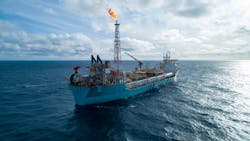Hurricane assessing future production options for Lancaster west of Shetland
Offshore staff
GODALMING, UK – Hurricane Energy is proposing a financial restructuring to allow the company to continue operations, following disappointing results from its early production system (EPS) at the basement Lancaster oil field west of Shetland.
Lancaster has been developed with two production wells, P6 and 205/21a-7z (P7z). The goals of the EPS have been to assess the performance of the complex reservoir, provide dynamic data to help refine reserves/resource estimates, and to support potential future development phases.
But production rates, water cut, and reservoir pressure have all been below expectations, with the P7z well having been shut-in since last May due to high water cut.
The technical review that followed included changes to the geological model, and a downgrading of Lancaster’s reserves and resources.
Currently the field is producing solely from the P6 well, with artificial lift supplied via an electric submersible pump (ESP) to support production.
Last month, pressure variability was observed in the P6 well while using the lower ESP, and investigations revealed a potential partial obstruction to fluid flow above the pump.
A well intervention restored production to prior rates by switching to use of the well’s upper ESP, although the root cause of the obstruction remains under assessment. Should the upper ESP too fail, it may not be possible to restore the lower ESP to full function, which could mean flowing the well at lower rates.
However, Hurricane believes it now has a better understanding of the well. It has put together updated business plan scenarios and has reviewed future development options for Lancaster with its technical advisors.
Three scenarios are:
- No further investment in Lancaster, with operations to wind down once production is no longer economic, followed by decommissioning
- Potential future recovery from the Lancaster field of 10 MMbbl
- Lancaster production to average 8,500-10,500 b/d in 2021, based on output from the P6 well alone on artificial lift via ESP and a 90% production efficiency estimate. Lancaster is currently producing at 11,700 b/d from P6 with an associated water cut of 28%.
More positive action would include a side track of the existing P7z well (P8) being sanctioned by mid-2021 and drilled in 2022, designed to accelerate production, achieve a higher operating margin and improve production resiliency, and deliver first oil in July 2022.
Estimated capex is $84 million, with potential future recovery from Lancaster field of 11.6 MMbbl.
In addition, a water injector well would be drilled in 2023 following completion of P8 operations to improve the sweep efficiency of the Lancaster reservoir and support reservoir pressure.
Seismic acquisition may also be needed in summer 2022 to optimize design and downhole location of the water injector.
The water injector would be drilled from a seabed location within 400 m (1,312 ft) of the Lancaster manifold using existing subsea infrastructure (flowline, riser and umbilical). There would be a need for refurbishment of the water injection plant onboard the FPSO Aoka Mizu.
Hurricane estimates the associated capex at $96 million, but the additional measures could lift future recovery from the field to 18.7 MMbbl.
04/30/2021
